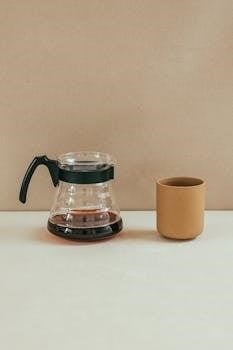
This guide provides essential instructions for operating your West Bend coffee pot. Proper use ensures optimal performance and delicious coffee. Carefully read each section to maximize your brewing experience. This manual will help you properly operate the coffee pot.
Overview of West Bend Coffee Pots
West Bend coffee pots are designed for brewing large quantities of coffee, often utilizing a percolating method. Models range from smaller, 12-cup programmable options to larger urns capable of brewing 30, 42, or even 55 cups. These pots are popular for both home use and events, due to their ability to serve many people. They often feature automatic temperature control to keep coffee warm after brewing. Some models offer programmable features, allowing users to schedule brewing times in advance. West Bend pots are known for their durability and ease of use. They may include features like a detachable power cord for easy storage. Materials used are typically stainless steel, ensuring long-lasting performance; Understanding your specific model is key to operating it properly. Always refer to your specific manual for the most accurate information. These pots are designed to simplify the process of brewing coffee.

Initial Setup and Preparation
Before first use, proper cleaning is essential. Fill the water tank and add coffee grounds to the basket. Ensure all components are correctly assembled. Then, you will be ready to brew.
Cleaning Before First Use
Prior to brewing your first pot of coffee, it’s crucial to thoroughly clean your West Bend coffee pot. Begin by washing the inside of the pot using a soft sponge and warm, soapy water. For the stem well, a scouring pad may be necessary to remove any manufacturing residues. Carefully lift the lever to allow the soapy water to drain from the spout into a sink or basin. Ensure you rinse the coffee maker with fresh water multiple times, allowing all soap residue to be completely removed. This initial cleaning process will ensure that your first brew will be free of any unwanted tastes or odors from the manufacturing process. This is a very important step.
Filling the Water Tank
To prepare your West Bend coffee pot for brewing, begin by filling the water tank with fresh, cold water. The amount of water you add will depend on the desired number of cups you intend to brew. Consult the markings inside the water tank or the instruction manual for precise measurements. Avoid overfilling, as this can lead to overflow during the brewing process. Ensure the water level does not exceed the maximum fill line indicated on the pot. Using the correct amount of water is essential for achieving the desired coffee strength. Always use cold, fresh water to get the best possible result.
Adding Coffee Grounds
After filling the water tank, the next step is to add your coffee grounds to the brew basket. For a 36-cup West Bend coffee maker, a general guideline is to use two cups of perk-ground coffee. However, the specific amount of coffee grounds you use will depend on your personal preference for coffee strength. You can adjust the quantity to achieve your desired taste. For smaller batches, reduce the coffee grounds accordingly. Always ensure the basket is securely placed on the stem before adding coffee. It’s recommended to wet the basket prior to adding coffee grounds. This will help prevent any grounds from escaping into the carafe during brewing.

Brewing Process
The brewing process involves starting the cycle, understanding the signals, and the standby mode. Once you have added water and grounds, the brewing process will begin and the coffee pot will beep.
Starting the Brewing Cycle
To initiate the brewing cycle on your West Bend coffee pot, ensure that the water tank is filled to the desired level and that the correct amount of coffee grounds has been added to the filter basket. Carefully position the basket and stem. Then, securely place the lid onto the coffee maker. Next, plug the coffee maker into a grounded power outlet. Press the power or brew button to start the brewing process. The machine will beep to indicate it has started the cycle. The brewing process will begin and the coffee will start to percolate. The time can vary depending on the model. During brewing ensure that no part of the coffee maker is removed, as scalding can occur. Allow the full cycle to complete without interruption for best results.
Understanding the Beep Signals
West Bend coffee pots use beep signals to communicate different stages of the brewing process. Typically, a beep will sound when the brewing cycle begins, indicating that the machine has started heating the water and is preparing to brew your coffee. A single beep indicates the brewing cycle has finished. This also signals that the coffee maker has switched to standby mode. This means the coffee is ready to be served, and the machine is keeping it warm. Be aware of these signals, as they are designed to alert you to when the brewing process is complete and avoid accidents. Pay attention to these beeps for optimal use. If you are unsure of any beep signals, consult your user manual or the West Bend website for further clarification.
Standby Mode After Brewing
Once the brewing cycle is complete, your West Bend coffee pot will automatically enter standby mode. This mode is designed to keep your freshly brewed coffee warm for a period of time. The ‘BREW’ light on the display will typically turn off to indicate that the brewing process has finished and the unit is in standby mode. It’s important to note that the coffee pot is still using a small amount of energy to maintain the temperature of the coffee. While in standby mode, the coffee maker is not actively brewing. The standby mode is an energy-saving feature that keeps the coffee hot without continuous brewing. If you do not want to keep the coffee warm, you can unplug it to save power. Remember that the length of time the coffee stays warm can vary.

Maintenance and Care
Proper maintenance ensures the longevity of your West Bend coffee pot. Regular cleaning and descaling are essential. Follow the instructions to keep your coffee maker in excellent condition. This will help prevent malfunctions.
Regular Cleaning Instructions
To maintain your West Bend coffee pot, clean the inside using a soft sponge and warm, soapy water after each use. For the stem well, a scouring pad might be necessary to remove any stubborn coffee residue. Ensure all sudsy water is completely drained from the spout before rinsing. Thoroughly rinse all parts and dry them to prevent mineral buildup. For the exterior, a damp cloth is sufficient. Avoid using abrasive cleaners which can damage the finish. Regularly cleaning your coffee pot will not only extend its life but also ensure each brew has the best possible flavor. Always unplug the unit before cleaning any of its parts. This process is crucial for optimal performance.
Descaling Procedures
Descaling is essential for removing mineral deposits that can accumulate in your West Bend coffee pot over time, affecting its performance and the taste of your coffee. Regular descaling, every two weeks or as needed, is recommended. To descale, fill the pot with a mixture of equal parts white vinegar and water. Run a full brewing cycle without coffee grounds, allowing the solution to work its way through the system. Once the cycle is complete, discard the vinegar solution and rinse the pot thoroughly with fresh water, running another cycle with just water. This process will remove mineral buildup and ensure your coffee pot continues to brew efficiently. Repeat this if necessary.

Additional Information
This section provides further details regarding filter usage and warranty details for your West Bend coffee pot. Refer to these for optimal use and peace of mind. This information will help you.
Filter Usage
Many West Bend coffee pots can function effectively with or without a paper filter. For regular grind coffee, wetting the basket before adding grounds is essential when not using a filter. This method prevents grounds from passing through and ensures cleaner coffee. However, for finer grinds, a paper filter is usually recommended to avoid sediment in your brew. Some users prefer filters for easier cleanup. The size of the filter will depend on your specific model; check the manual. While some users successfully brew without filters, using filters can provide a more consistent and sediment-free coffee. Always consult your model’s specific manual for filter compatibility and recommendations. Experiment with both methods to find your preferred brewing method.
Warranty Details
West Bend typically offers a limited warranty for their coffee pots, usually covering defects in materials and workmanship for a specific period, often one year from the original purchase date. This warranty is valid only if the appliance is operated according to the instructions provided in the user manual. The warranty does not cover damage caused by misuse, accidents, or unauthorized repairs. To claim warranty service, you’ll likely need proof of purchase, such as a receipt, and to contact West Bend or an authorized service center. Carefully check your specific model’s warranty information found in your product manual or on the company website. The warranty details may vary depending on the specific product and its manufacturing date. Always register your appliance online as this can expedite the warranty process.